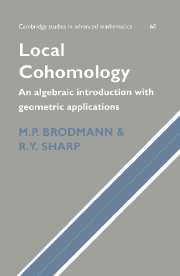Book contents
- Frontmatter
- Contents
- Dedication
- Preface
- Notation and conventions
- 1 The local cohomology functors
- 2 Torsion modules and ideal transforms
- 3 The Mayer-Vietoris Sequence
- 4 Change of rings
- 5 Other approaches
- 6 Fundamental vanishing theorems
- 7 Artinian local cohomology modules
- 8 The Lichtenbaum-Hartshorne Theorem
- 9 The Annihilator and Finiteness Theorems
- 10 Matlis duality
- 11 Local duality
- 12 Foundations in the graded case
- 13 Graded versions of basic theorems
- 14 Links with projective varieties
- 15 Castelnuovo regularity
- 16 Bounds of diagonal type
- 17 Hilbert polynomials
- 18 Applications to reductions of ideals
- 19 Connectivity in algebraic varieties
- 20 Links with sheaf cohomology
- Bibliography
- Index
1 - The local cohomology functors
Published online by Cambridge University Press: 04 May 2010
- Frontmatter
- Contents
- Dedication
- Preface
- Notation and conventions
- 1 The local cohomology functors
- 2 Torsion modules and ideal transforms
- 3 The Mayer-Vietoris Sequence
- 4 Change of rings
- 5 Other approaches
- 6 Fundamental vanishing theorems
- 7 Artinian local cohomology modules
- 8 The Lichtenbaum-Hartshorne Theorem
- 9 The Annihilator and Finiteness Theorems
- 10 Matlis duality
- 11 Local duality
- 12 Foundations in the graded case
- 13 Graded versions of basic theorems
- 14 Links with projective varieties
- 15 Castelnuovo regularity
- 16 Bounds of diagonal type
- 17 Hilbert polynomials
- 18 Applications to reductions of ideals
- 19 Connectivity in algebraic varieties
- 20 Links with sheaf cohomology
- Bibliography
- Index
Summary
The main objective of this chapter is to introduce the a-torsion functor Γa (throughout the book, a always denotes an ideal in a (non-trivial) commutative Noetherian ring R) and its right derived functors, referred to as the local cohomology functors with respect to a. We shall see that Γa is naturally equivalent to the functor and, indeed, that is naturally equivalent to the functor for each i ≥ 0; moreover, as Γa turns out to be left exact, the functors Γa and are naturally equivalent.
This chapter also serves notice that our approach is based on fundamental techniques of homological commutative algebra, such as ones based on connected sequences of functors (see [52, pp. 212–214]): readers familiar with such ideas, and with the local cohomology functors, might like to just glance through this chapter and to move rapidly on to Chapter 2.
Torsion functors
Definition. For each R-module M, set, the set of elements of M which are annihilated by some power of a. Note that Γa(M) is a submodule of M. For a homomorphism f : M → N of R-modules, we have f(Γa(M)) ⊆ Γa(N), and so there is a mapping Γa(f) : Γa(M)→ Γa(N) which agrees with f on each element of Γa(M).
It is clear that, if g : M – N and h : N → L are further homomorphisms of R-modules and r ∈ R, then Γa(h o f) = Γa(h) o Γa(f), Γa(f + g) = Γa(f) + Γa(g), Γa(rf) = r Γa(f) and Γa(IdM) = Id Γa(M).
- Type
- Chapter
- Information
- Local CohomologyAn Algebraic Introduction with Geometric Applications, pp. 1 - 16Publisher: Cambridge University PressPrint publication year: 1998

